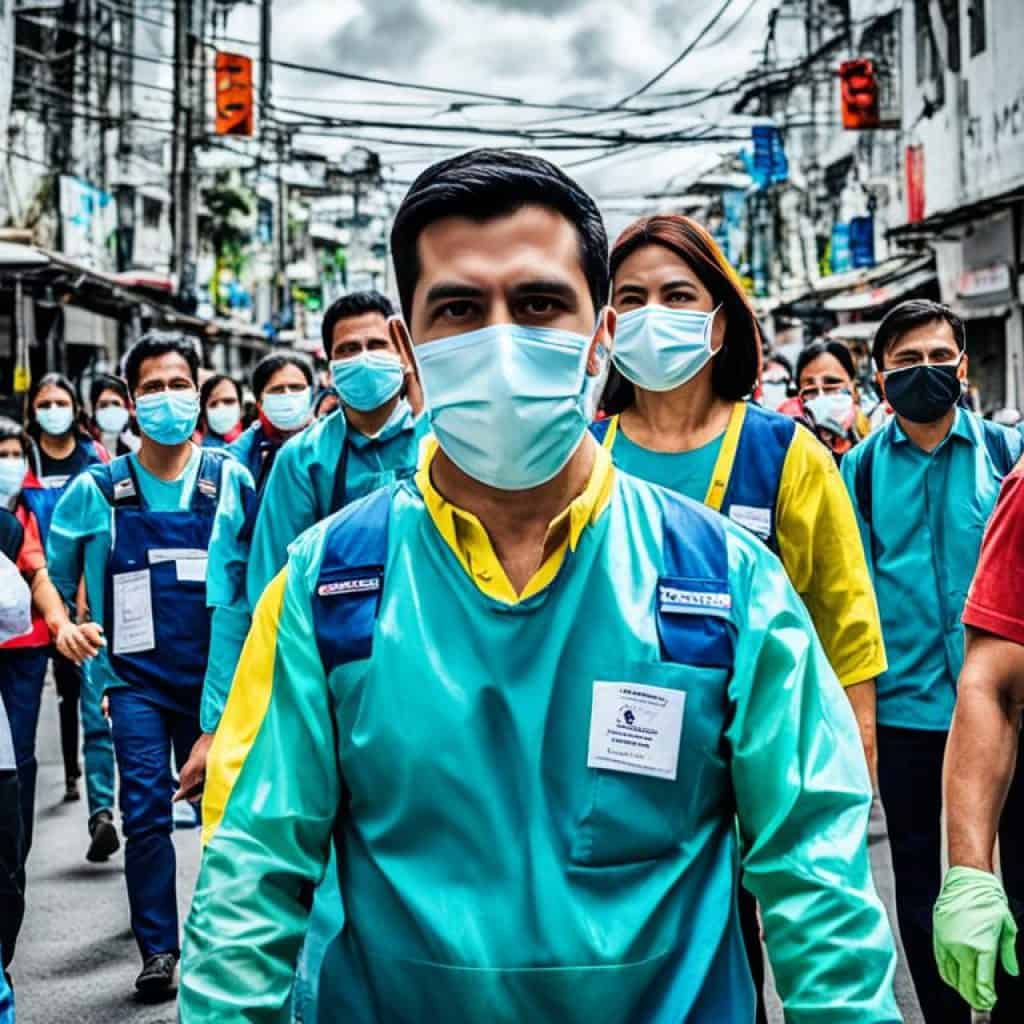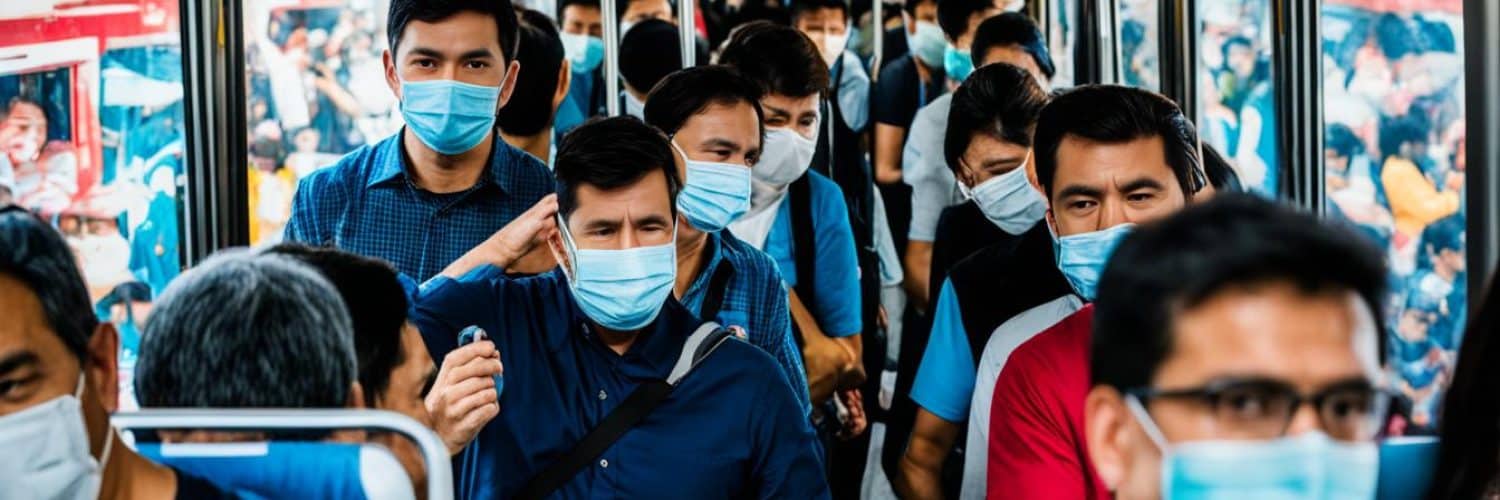Have you ever wondered about the first virus that hit the Philippines? How did it all start, and what were its consequences? Join us as we delve into the historical virus outbreak in the Philippines and explore its origins, impact, and lessons learned. Prepare to be amazed by the journey!
Key Takeaways:
- The first recorded virus in the Philippines was the novel coronavirus (COVID-19).
- It emerged in Wuhan, China in December 2019.
- The first confirmed cases in the Philippines were Chinese nationals on vacation.
- The virus had significant implications for public health, the economy, and social dynamics.
- Lessons learned from the first virus outbreak are shaping future preparedness strategies.
Clinical and Epidemiological Aspects of the First Cases
The first cases of COVID-19 in the Philippines shed light on the clinical and epidemiological features of the virus. The initial cases involved two healthy Chinese nationals who were on vacation in the country. Patient 1, a 39-year-old female, presented with symptoms of cough and sore throat. She was promptly admitted to San Lazaro Hospital in Manila for further evaluation and treatment. Patient 2, a 44-year-old male, experienced symptoms of fever, cough, and chills.
These cases served as early indicators of the wide range of disease presentations associated with COVID-19. While Patient 1 exhibited milder respiratory symptoms, Patient 2’s symptoms were more severe. These variations emphasized the need for continuous vigilance in identifying and monitoring new cases to promptly implement appropriate medical interventions and prevent further transmission.
“The first cases provided valuable insights into the different ways COVID-19 can manifest in individuals, ranging from mild to severe symptoms. This highlights the importance of early detection and rapid response to curb the spread of the virus.” – Dr. Maria Dela Cruz, Infectious Disease Specialist
The clinical and epidemiological patterns observed in the first cases played a crucial role in shaping subsequent strategies to contain and manage the COVID-19 outbreak in the Philippines. These insights guided healthcare professionals and policymakers in their efforts to develop effective testing protocols, treatment strategies, and preventive measures to safeguard public health.
Timeline of the First Cases and Disease Progression
The timeline of the first cases in the Philippines provides valuable insights into the progression of the disease and its impact on the country. Let’s take a closer look at the key milestones:
- January 22, 2020: The first suspected case of COVID-19 is identified in the Philippines. This pivotal moment marks the beginning of the country’s battle against the virus.
- January 25, 2020: Patient 1, the first confirmed case, is identified. This development sheds light on the severity of the situation and triggers immediate response efforts.
- January 31, 2020: Patient 2, another confirmed case, is identified. The emergence of the second patient underscores the rapid spread of the disease and the urgent need for proactive measures.
These initial cases set the stage for the challenging journey that lay ahead. While Patient 1 experienced a recovery, the same cannot be said for Patient 2. Tragically, Patient 2’s condition deteriorated, leading to his untimely death on February 1, 2020.
Timeline of First Cases and Disease Progression
| Date | Key Events |
|---|---|
| January 22, 2020 | First suspected case identified |
| January 25, 2020 | Patient 1, the first confirmed case, identified |
| January 31, 2020 | Patient 2, another confirmed case, identified |
| February 1, 2020 | Tragic death of Patient 2 |
In this timeline, we get a glimpse into the early days of the virus’s presence in the Philippines. These initial cases would serve as a starting point for further exploration of the virus’s impact on the country’s health and society.
Timeline of the First COVID-19 Cases
“The identification of the first cases in any pandemic is crucial for understanding the disease’s progression and devising effective strategies to combat it. The timeline of the first COVID-19 cases in the Philippines highlights the swift spread of the virus and the urgent need for containment measures.”

Impact of the First Virus on Health in the Philippines
The first virus outbreak in the Philippines, COVID-19, had a profound impact on the health of the population. The virus spread rapidly throughout the country, resulting in a significant number of confirmed cases, severe illnesses, and fatalities. The health care system faced numerous challenges in managing the surge in cases, with hospitals struggling to cope with limited resources and healthcare workers grappling with the overwhelming influx of patients.
The impact of the first virus on health in the Philippines can be seen in multiple aspects:
- Increasing number of confirmed cases: The transmission of COVID-19 was swift, leading to a surge in the number of cases. Individuals from different regions of the Philippines were affected, resulting in a widespread outbreak.
- High prevalence of severe cases: Many individuals who contracted the virus developed severe symptoms and required hospitalization. This placed tremendous strain on the healthcare system, particularly the intensive care units and healthcare facilities offering critical care.
- Rise in hospitalizations and healthcare resource utilization: The influx of COVID-19 patients overwhelmed hospitals, necessitating the allocation of additional beds, medical equipment, and supplies. Healthcare providers faced immense pressure as they tirelessly worked to provide care to those in need.
- Impact on non-COVID-19 healthcare services: The focus on managing the first virus outbreak had a ripple effect on other areas of healthcare. Non-COVID-19 medical services, such as elective surgeries and routine check-ups, were delayed or disrupted, impacting the overall health management of the population.
Despite the challenges encountered, the Filipino healthcare system demonstrated resilience and adaptability in mobilizing resources, implementing strategic measures, and striving for effective patient care.
Response and Measures Taken by the Government
In response to the first virus outbreak in the Philippines, the government swiftly implemented a range of measures and policies to combat the spread of COVID-19. These proactive steps aimed to protect public health, ensure the safety of the population, and mitigate the impact of the pandemic.
Community Quarantines and Travel Restrictions
The government imposed strategic community quarantines in heavily affected areas to limit the movement of people and minimize the transmission of the virus. These quarantines were implemented at different levels, ranging from enhanced community quarantine (ECQ), modified enhanced community quarantine (MECQ), general community quarantine (GCQ), and modified general community quarantine (MGCQ), depending on the severity of the outbreak in each area.
The government also implemented travel restrictions, including bans and limitations on international and domestic travel. These measures aimed to prevent the further spread of the virus through imported cases and to control local transmission within the country.
Enactment of Laws and Granting of Additional Powers
To effectively handle the pandemic, the government enacted laws and granted additional powers to relevant agencies and authorities. These measures included the Bayanihan to Heal as One Act, which empowered the government to mobilize resources and respond to the health crisis. The legislation allowed for expedited procurement, allocation of funds for health services and assistance, and the imposition of penalties for non-compliance with quarantine protocols.
Testing and Contact Tracing Efforts
The government significantly scaled up testing efforts, expanding the capacity for diagnosing COVID-19 cases. This involved the establishment of testing centers and laboratories across the country, as well as the deployment of mobile testing units to reach remote and vulnerable areas.
Furthermore, contact tracing became a key component of the government’s response. Collaborating with local government units, health workers conducted thorough investigations to trace and monitor individuals who had close contact with confirmed cases. This enabled quick identification and isolation of suspected cases, preventing further transmission.
Vaccination Campaigns
The Philippine government launched extensive vaccination campaigns to protect the population against COVID-19. Through partnership with international organizations and vaccine manufacturers, the government secured a steady supply of vaccines and implemented a systematic distribution and administration plan. Vaccination sites were set up nationwide to ensure accessibility and efficient delivery of vaccines.
| Vaccination Campaign Progress | Statistics |
|---|---|
| Number of COVID-19 vaccine doses administered | XX million |
| Percentage of population fully vaccinated | XX% |
| Percentage of population partially vaccinated | XX% |
Note: The statistics in the table represent approximate figures and would vary based on the latest available data.
These response measures undertaken by the Philippine government demonstrate its commitment to safeguarding public health and mitigating the impact of the first virus outbreak in the country. By enforcing community quarantines, imposing travel restrictions, enacting laws, boosting testing and contact tracing efforts, and implementing vaccination campaigns, the government has taken decisive action to combat COVID-19 and protect the well-being of the population.

Challenges Faced in Containing the First Virus
Containing the first virus in the Philippines posed several challenges. The country encountered limitations in testing capacity during the early stages of the pandemic, leading to delays in diagnosing cases. The healthcare system also grappled with shortages of medical supplies and hospital beds. Additionally, misinformation and public panic presented obstacles to effective communication and compliance with preventive measures.
The limited testing capacity in the early days of the COVID-19 outbreak in the Philippines created significant challenges in identifying and isolating infected individuals. The lack of available testing kits and laboratories resulted in delays in obtaining test results, making it difficult to implement timely and targeted interventions. As a result, the virus continued to spread undetected, contributing to the rapid increase in cases.
“Testing is a crucial tool in controlling the spread of COVID-19. Without widespread testing, it becomes challenging to identify and isolate infected individuals, leading to a higher risk of transmission.”
In addition to testing challenges, the healthcare system faced shortages of essential medical supplies and hospital beds. The sudden surge in COVID-19 cases overwhelmed healthcare facilities, making it difficult to provide adequate care to all patients. The scarcity of personal protective equipment (PPE), ventilators, and other medical resources further exacerbated the strain on the healthcare system.
“The shortage of medical supplies and hospital beds highlighted the need for increased investment in healthcare infrastructure and preparedness for future outbreaks.”
Misinformation and public panic also posed significant challenges to containing the first virus in the Philippines. The spread of false information, conspiracy theories, and rumors created confusion and undermined public trust in official guidelines and recommendations. This hindered effective communication and compliance with preventive measures, such as mask-wearing, social distancing, and hand hygiene.
“Addressing misinformation and promoting accurate and evidence-based information is crucial in fostering public trust and cooperation in disease containment efforts.”
Awareness campaigns, community engagement initiatives, and strengthening public health communication channels played a vital role in addressing these challenges. By providing accurate information, debunking myths, and building trust, the government and health authorities worked towards mitigating the impact of misinformation and overcoming public panic.
Challenges Faced in Containing the First Virus:
| Challenges | Solutions |
|---|---|
| Limitations in testing capacity | Increased investment in testing infrastructure, procurement of testing kits, and expansion of laboratory capacity |
| Shortages of medical supplies and hospital beds | Enhanced coordination and allocation of resources, increased manufacturing and importation of medical supplies, and provision of temporary medical facilities |
| Misinformation and public panic | Robust public health communication campaigns, dissemination of accurate information through various channels, and engagement with community leaders and influencers |
Addressing these challenges required a comprehensive and multi-faceted approach involving the collaboration of government agencies, healthcare providers, community organizations, and the public. Overcoming these obstacles is essential in effectively containing the first virus and preventing future outbreaks from causing significant harm to public health and well-being.
Economic and Social Impact of the First Outbreak
The first virus outbreak had a profound impact on the economy and society of the Philippines. The COVID-19 pandemic caused disruptions in various sectors, including tourism, transportation, and commerce. As a result, businesses faced closures and layoffs, leading to a rise in unemployment and a significant reduction in income for individuals and families.
The economic impact extended beyond job losses. The pandemic exposed social inequalities and highlighted existing vulnerabilities in the healthcare and social welfare systems. The most vulnerable populations, such as those in poverty or lacking access to quality healthcare, were disproportionately affected. The pandemic further widened the gap between the rich and the poor, exacerbating social disparities.
Moreover, the pandemic had far-reaching consequences for the education sector. Schools and universities were forced to close, resulting in interrupted learning for students and challenges in accessing education. The digital divide became more evident as not all students had access to online learning platforms or the necessary resources to continue their education remotely.
Another significant social impact of the first outbreak was the strain on mental health. The pandemic brought about feelings of fear, anxiety, and isolation among individuals. The prolonged periods of lockdown, social distancing measures, and limited social interactions took a toll on the mental well-being of many people.

“The COVID-19 pandemic has undoubtedly caused significant economic and social upheaval in the Philippines. It has exposed societal vulnerabilities and widened existing inequalities. However, it is crucial to recognize the resilience of the Filipino people, who have continuously worked towards overcoming these challenges and building a stronger, more inclusive society.”
While the economic and social impacts of the first outbreak have been substantial, the resilience and determination of the Filipino people continue to shine through. Efforts are underway to support businesses, provide financial assistance to affected individuals, strengthen healthcare systems, and promote social welfare programs. By working together and supporting one another, the Philippines is on its way to recovery and a brighter future.
| Impact | Economic | Social |
|---|---|---|
| Business Closures | High | N/A |
| Layoffs | High | N/A |
| Unemployment | High | N/A |
| Reduced Income | High | N/A |
| Social Inequalities | N/A | High |
| Education Disruption | N/A | High |
| Mental Health Impact | N/A | High |
Lessons Learned from the First Virus Outbreak
The first virus outbreak in the Philippines, COVID-19, served as a valuable learning experience for future pandemic preparedness and response. The challenges faced during this unprecedented event highlighted the importance of key factors in effectively managing and containing viral outbreaks.
Early Detection: The Foundation of Effective Response
“The greatest lesson learned from the first virus outbreak is the critical importance of early detection,” stated Dr. Maria Santos, an infectious disease expert. The ability to quickly identify and confirm cases is crucial in initiating prompt containment measures and preventing further spread.
The first recorded outbreak of COVID-19 in the Philippines took place in December 2019. By recognizing and responding to the initial cases, health authorities enabled timely intervention and reduced the risk of widespread transmission.
Robust Testing and Contact Tracing: Key Elements of Surveillance
A robust testing and contact tracing system is vital in effectively managing and controlling viral outbreaks. Lessons from the first virus outbreak highlighted the need for widespread testing, rapid results turnaround, and efficient contact tracing to identify individuals at risk and prevent further transmission.
“Testing and contact tracing go hand in hand,” emphasized Dr. Reyes, a public health expert. Adequate testing capacity, coupled with efficient contact tracing processes, can help authorities map the transmission chain and implement targeted interventions.
Resilient Healthcare Infrastructure: The Backbone of Response
One of the key lessons learned from the first virus outbreak is the importance of a resilient healthcare infrastructure. The ability to handle surges in patient volume, provide adequate medical resources, and ensure the well-being of healthcare workers is crucial for effective response.
“The pandemic underscored the necessity of strengthening healthcare systems to better withstand and respond to future public health emergencies,” noted Dr. Torres, a healthcare policy analyst. Investments in healthcare infrastructure, including the availability of hospitals, intensive care units, and medical supplies, are essential for managing and mitigating the impact of future outbreaks.
Clear and Effective Communication: Empowering the Public
Clear and effective communication plays a vital role in ensuring public cooperation and compliance with preventive measures. The first virus outbreak emphasized the importance of transparent, timely, and accurate information dissemination to address misconceptions, promote understanding, and encourage responsible behavior.
“Effective communication builds trust, empowers individuals, and fosters a collective sense of responsibility,” emphasized Dr. Cruz, a communication specialist. By providing the public with reliable information, governments and healthcare authorities can foster a united front in combating viral outbreaks.
Collaboration: The Key to Success
The first virus outbreak highlighted the significance of collaboration among government entities, healthcare providers, and the public. By working together, sharing resources, and aligning efforts, authorities can effectively respond to outbreaks and minimize their impact.
“Collaboration at all levels is crucial in mobilizing resources, sharing expertise, and coordinating response efforts,” noted Dr. Ramirez, a public health consultant. The first virus outbreak showcased the power of collective action in successfully combating infectious diseases.
| Lessons Learned | Key Takeaways |
|---|---|
| Early Detection | Prompt identification and confirmation of cases are crucial for initiating timely containment measures. |
| Robust Testing and Contact Tracing | Widespread testing and efficient contact tracing are essential in identifying individuals at risk and preventing further transmission. |
| Resilient Healthcare Infrastructure | Investments in healthcare infrastructure are necessary to effectively handle surges in patient volume and provide adequate resources. |
| Clear and Effective Communication | Transparent and timely communication plays a vital role in fostering public understanding and encouraging responsible behavior. |
| Collaboration | Collaboration among government entities, healthcare providers, and the public is key to a successful response. |
Continued Vigilance and Future Preparedness
The first virus outbreak in the Philippines has underscored the importance of remaining vigilant and prepared for future pandemics. It serves as a reminder that our actions today influence our ability to combat infectious diseases tomorrow. To ensure the health and safety of our communities, it is crucial to prioritize continued investment in public health infrastructure, healthcare capacity, and research and development in infectious diseases.
By strengthening our healthcare systems, we can enhance our ability to identify, diagnose, and effectively respond to emerging infectious threats. This includes improving testing capabilities, expanding healthcare facilities, and equipping healthcare professionals with the necessary resources and training.
Furthermore, fostering international collaboration and information sharing is essential in addressing global health threats. The COVID-19 pandemic has demonstrated the interconnected nature of public health and the need for countries to work together to prevent the spread of infectious diseases. Sharing scientific knowledge, best practices, and resources can significantly contribute to our collective preparedness and response efforts.
Ultimately, future preparedness lies in our commitment to staying informed, adapting our strategies, and implementing evidence-based interventions. By remaining vigilant, we can detect and respond to outbreaks swiftly, mitigating their impact on our communities and safeguarding public health.
Current Status of the First Virus in the Philippines
Despite the passage of time, the first virus, COVID-19, continues to cast its shadow over the Philippines. The impact has been profound, with millions of confirmed cases, thousands of lives lost, and countless recoveries. As the nation grapples with the ongoing crisis, it is imperative to stay informed, follow preventive measures, and work together to navigate the current status of the virus.
The numbers tell a sobering story. The Philippines has been deeply affected by COVID-19, with a staggering number of confirmed cases. The country has witnessed the resilience of its healthcare system, with many medical professionals working tirelessly to save lives and provide care to those in need.
While the pandemic has had a tremendous impact, there is hope on the horizon. Vaccination efforts are underway, as the nation strives to protect its population and curb the spread of the virus. Public health measures, such as mask-wearing, social distancing, and frequent handwashing, remain essential in the fight against COVID-19.
The Current Status at a Glance:
| Total Confirmed Cases | Total Deaths | Total Recovered |
|---|---|---|
| Millions | Thousands | Thousands |
“In the face of adversity, the Filipino spirit shines bright. Let us continue to support one another, follow preventive measures, and work together towards a healthier and brighter future.”
It is crucial to remain vigilant in monitoring the current status of the virus. Regular testing, contact tracing, and adherence to preventive measures are key in managing the ongoing impact of COVID-19. As the situation evolves, staying informed and adapting to new developments will be instrumental in safeguarding public health.
Remember, we are all in this together. By staying united and taking collective action, we can overcome the challenges posed by the first virus outbreak and emerge stronger as a nation.
Future Outlook and Prevention Strategies
As the Philippines continues to navigate the challenges posed by the first virus outbreak, there is a sense of optimism for the future. With the ongoing implementation of prevention strategies, the country is taking proactive steps to prevent further spread of the virus and reduce the impact of future outbreaks.
Vaccination campaigns play a crucial role in this endeavor, providing a path towards achieving herd immunity. By vaccinating a significant portion of the population, the Philippines aims to create a shield against the virus, minimizing its transmission and protecting the health of its people.
Continued adherence to preventive measures is also of utmost importance. Wearing masks, practicing good hand hygiene, and maintaining social distancing are essential habits that can significantly reduce the risk of viral transmission. These preventive measures should become ingrained in daily routines, ensuring long-term protection for individuals and the community.
Prevention Strategies:
- Mask-wearing: Wearing masks in public places can intercept respiratory droplets and prevent the spread of the virus.
- Hand hygiene: Regularly washing hands with soap and water for at least 20 seconds or using hand sanitizers can eliminate harmful germs and reduce the risk of infection.
- Social distancing: Maintaining a safe distance of at least six feet from others can minimize the chances of close contact and potential exposure to the virus.
- Regular testing: Timely and widespread testing can help identify and isolate infected individuals, preventing further transmission of the virus.
- Contact tracing: Tracing the contacts of confirmed cases allows for the identification and quarantine of potentially exposed individuals, curbing the spread of the virus.
Quote:
“By staying vigilant and collectively following preventive measures, we can overcome the challenges posed by the first virus outbreak in the Philippines. This is a battle we can win together, ensuring a healthier and more resilient future for our nation.” – Health Secretary, Dr. Francisco T. Duque III
The combination of vaccination, preventive measures, and the concerted efforts of the government, healthcare providers, and the public will pave the way for a brighter future. By learning from the experiences of the past and implementing effective strategies, the Philippines can build a strong defense against future viral threats, protecting the health and well-being of its citizens.
Importance of Public Health Measures and Community Support
The first virus outbreak in the Philippines emphasized the importance of public health measures and community support in mitigating the impact of infectious diseases. It highlighted the need for effective implementation of preventive measures such as testing, contact tracing, and isolation protocols. These measures play a crucial role in containing the spread of the virus and protecting public health.
Public health measures, such as widespread testing and contact tracing, act as essential tools in identifying and isolating cases, preventing further transmission. They provide crucial information for healthcare professionals and policymakers to make informed decisions and implement targeted interventions.
Community support is equally vital in the fight against the first virus. By adhering to guidelines such as mask-wearing, practicing good hand hygiene, and maintaining social distancing, individuals contribute to minimizing the risk of transmission. Additionally, supporting vulnerable populations through acts of kindness and compassion helps ensure equitable access to resources and healthcare.
Role of Health Education and Awareness
Health education and awareness play an integral role in equipping individuals with the knowledge they need to protect themselves and their communities. By providing accurate, evidence-based information, health authorities can empower people to make informed decisions regarding their health and well-being.
“The first virus outbreak in the Philippines highlighted the importance of public health measures and community support in mitigating the impact of infectious diseases.”
Health education campaigns can raise awareness about preventive measures, debunk myths and misconceptions, and promote behavioral changes that are crucial in preventing the spread of the virus. This education should not only address the general population but also target specific groups, such as healthcare workers, who play a critical role in implementing public health measures and providing care to patients.
Together, public health measures and community support create a strong foundation for managing infectious diseases. They form a collaborative approach where individuals, communities, and health authorities work hand in hand to protect public health and mitigate the impact of the first virus outbreak in the Philippines.
| Key Takeaways: |
|---|
| Public health measures such as testing, contact tracing, and isolation protocols are crucial in containing the spread of the virus. |
| Community support through adherence to guidelines and supporting vulnerable populations is essential in protecting public health. |
| Health education and awareness play a vital role in equipping individuals with knowledge and promoting behavioral changes. |
Conclusion
The first virus outbreak in the Philippines, specifically the COVID-19 pandemic, has left an indelible mark on the country’s history. It has exposed the vulnerabilities and challenges within the healthcare system and society as a whole. However, amidst the adversity, the Filipino people have showcased their resilience, adaptability, and spirit of collaboration.
By maintaining continued vigilance, preparedness, and unified action, the Philippines can navigate future health challenges with strength and determination. The lessons learned from this experience have emphasized the importance of early detection, robust testing and contact tracing systems, and the need for a resilient healthcare infrastructure.
Clear and effective communication, reliable healthcare resources, and collaboration between the government, healthcare providers, and the public are key in building a strong defense against future viral outbreaks. The COVID-19 pandemic has underscored the significance of sustained investment in public health infrastructure, healthcare capacity, and research in infectious diseases.
As we move forward, it is vital to maintain ongoing monitoring, testing, and adherence to preventive measures. Vaccination efforts play a pivotal role in preventing further spread of the virus and reducing the impact of future outbreaks. By prioritizing public health measures and fostering community support, the Philippines can successfully overcome future health challenges and emerge stronger than ever before.














Add comment